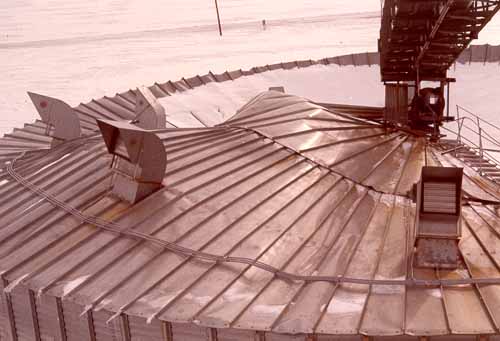UNSYMMETRICAL SNOW LOADING ON BUILDINGS
By
Charles C. Roberts, Jr., Ph.D., P.E.
Every year, roof structures fail after moderate snowfalls that would
not seem to be excessive. A significant ingredient in this
phenomenon is the condition of nonuniform snow load. The design
of most buildings assumes that the loading or force on the roof is
uniformly distributed. In moderate snowfalls with windy
conditions, drifts develop on the down-wind side of a roof, which
can be a significant load on the structure at a particular location.

Figure 1
Figure 1 shows a large snowdrift on the downwind side of a roof ridge. A
snowfall as low as 3-4 inches can result in drifting on the order of
2 - 3 feet. The unsymmetrical loading from snowdrifts can cause
different failure modes

Figure 2
when compared to uniform loading. Figure 2 is an example of how
unsymmetrical loading severely damaged a conical roof. A conical
roof is quite strong when the loading is uniformly distributed
downward. This allows the roof rafters and sheet metal to be in
plane and resist the load. When a snow load is applied on one side
of the roof, the roof rafters deflect downward in a local area,
causing a buckle in the structure. The buckle is inherently weak
and can cause local rafter failure, which is what lead to the
collapse of the conical grain bin roof.

Figure 3
Figure 3 shows a large drift that was over 2 feet deep on the down-
wind side of the roof ridge. This caused a localized collapse of the
roof in the area of the drift. It should be noted that the ground snow
depth was approximately 12 inches, while the drift depth on the
roof was over 2 feet. Snow density is a significant factor affecting
the amount of unbalanced load on a structure. Most building
designers and many building codes assume snow loading to be
uniform for simplicity's sake. There is insufficient data available in
the engineering literature on characteristics of nonuniform snow
load development. Consequently, no consensus has been reached
regarding how to handle building design with unbalanced snow
loading. In certain cases, as shown above, the uniform snow load
assumption may not be valid, and a collapse may occur as a result
of a nominal snowfall.
FOR TECHNICAL ARTICLES CONTACT CLAIMS MAGAZINE AND ASK
FOR A REPRINT OF A PAST TECHNICAL NOTEBOOK ARTICLE
CLAIMS MAGAZINE



